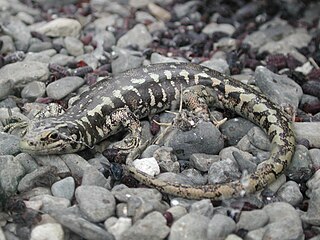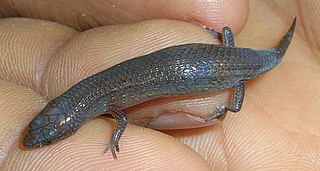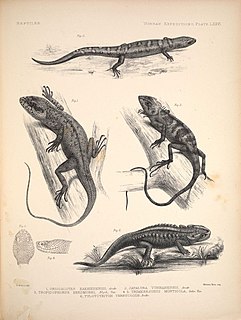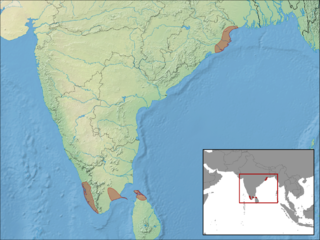Acontias is a genus of limbless skinks, the lance skinks, in the African subfamily Acontinae. Most are small animals, but the largest member of the genus is Acontias plumbeus at approximately 40 cm (16 in) snout-vent length. All members of this genus are live-bearing, sandswimmers, with fused eyelids. A recent review moved species that were formerly placed in the genera Typhlosaurus, Acontophiops, and Microacontias into this genus, as together these form a single branch in the tree of life. This new concept of Acontias is a sister lineage to Typhlosaurus, and these two genera are the only genera within the subfamily Acontinae.

Cryptoblepharus is a genus of skinks

Lipinia is a genus of skinks, lizards in the family Scincidae. Species in the genus Lipinia are commonly called lipinias.
Nessia is a genus of skinks, lizards in the family Scincidae. The genus is endemic to Sri Lanka. Species in the genus Nessia are commonly known as snake skinks.

Oligosoma is a genus of small to medium-sized skinks found only in New Zealand as well as Norfolk and Lord Howe islands. Oligosoma had previously been found to belong to the Eugongylus group of genera in the subfamily Lygosominae; the Australian genus Bassiana appears to be fairly closely related.

Ristella is a genus of skinks endemic to the Western Ghats of southwestern India. They are commonly known as cat skinks because of their retractile claws. This genus can be instantly identified by the presence of only four fingers in forelimbs in all the species. All the members look more or less similar and are drab dark brown to blackish in complexion with paler undersides. This poorly known groups of lizards are diurnal, insectivorous, terrestrial to semi fossorial in habits. They inhabit deep leaf-litter and grasslands in montane forests and rainforests.

Tropidophorus is a genus of semiaquatic lizards in the skink family (Scincidae), found in Indochina, Borneo, Sulawesi, and the Philippines. They are sometimes known as water skinks or waterside skinks.
The Haly's tree skink is a species of tree skink found in Sri Lanka. Earlier thought to be found also in the Western Ghats, taxonomic studies have shown this to be a Sri Lankan endemic, differentiated from the Indian Dasia subcaeruleum. It is the only arboreal skink in Sri Lanka.
The Nicobar tree skink or Nicobar dasia is a species of arboreal skink found in the Nicobar Islands of India.

Dasia olivacea, the olive dasia or olive tree skink, is a species of skink native to Southeast Asia.
Boulenger's dasia or Boulenger’s tree skink is a species of tree skink endemic to the Western Ghats in south India.
Vosmer's writhing skink is a species of skink, a lizard in the family Scincidae. The species is endemic to India.

Bibron's skink or seashore skink is a species of skink, a lizard in the family Scincidae. The species is endemic to India and Sri Lanka.

Ristella rurkii, commonly known as Rurk's ristella, is a species of skink endemic to the Western Ghats of southern India. It is a small, insectivorous, diurnal skink found in shola grasslands and rainforests of hills ranges in parts of Tamil Nadu and Kerala states of India.

Trachylepis is a skink genus in the subfamily Lygosominae found mainly in Africa. Its members were formerly included in the "wastebin taxon" Mabuya, and for some time in Euprepis. As defined today, Trachylepis contains the clade of Afro-Malagasy mabuyas. The genus also contains a species from the Brazilian island of Fernando de Noronha, T. atlantica, and may occur in mainland South America with Trachylepis tschudii and Trachylepis maculata, both poorly known and enigmatic. The ancestors of T. atlantica are believed to have rafted across the Atlantic from Africa during the last 9 million years.

Eutropis is a genus of skinks belonging to the subfamily Lygosominae. For long, this genus was included in the "wastebin taxon" Mabuya; it contains the Asian mabuyas. They often share their habitat with the related common skinks (Sphenomorphus), but they do not compete significantly as their ecological niches differ.

Dasia griffini, commonly known as Griffin's keel-scaled tree skink, is a species of tree skink, a lizard in the family Scincidae. The species is endemic to central and northern Palawan and southern Mindoro in the Philippines.
Nessia burtonii, commonly known as Burton's nessia, Gray's snake skink, or the three-toed snake skink, is a species of skink, a lizard in the family Scincidae. The species is endemic to the island of Sri Lanka.
Shelford's skink is a species of skink known only from Sarawak, Malaysia. It is an uncommon arboreal species.











